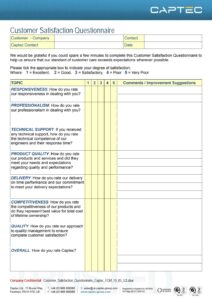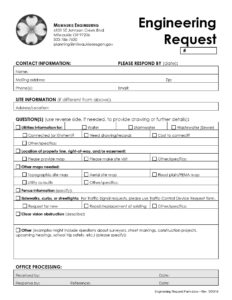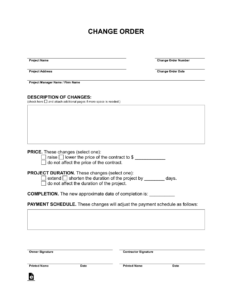Utilizing a standardized form promotes transparency and accountability by documenting all changes in a consistent manner. This reduces the risk of disputes arising from miscommunication or undocumented agreements. Furthermore, it streamlines the approval process, ensuring that all relevant parties are informed and can contribute to decision-making regarding project adjustments. Efficient change management contributes to successful project delivery within budget and on schedule.
Understanding the components and usage of this type of structured documentation is crucial for effective contract administration. The following sections will explore best practices for completion, submission, and approval processes, as well as discuss the importance of integrating these procedures into a robust project management framework.
Key Components of a Variation Order Request
Effective variation order management requires meticulous documentation of all requested changes. Several key components ensure clarity and facilitate a smooth approval process.
1: Project Identification: Clear identification of the relevant project, including the project name, contract number, and relevant parties involved, is essential for proper tracking and context.
2: Variation Order Number: A unique identifying number assigned to each variation order allows for easy referencing and organized record-keeping.
3: Description of Change: A detailed and unambiguous description of the proposed modification to the scope of work is crucial for accurate assessment and approval. This should clearly outline the nature and extent of the change.
4: Justification for Change: A clear explanation of the reasons necessitating the change ensures transparency and aids in evaluating the validity of the request.
5: Cost Implications: A comprehensive breakdown of the cost impact, including both direct and indirect costs, must be provided. This should detail any changes to material, labor, or equipment expenses.
6: Schedule Impact: An assessment of the impact on the project timeline, including potential delays or changes to key milestones, allows for proactive schedule adjustments.
7: Supporting Documentation: Relevant supporting documentation, such as drawings, specifications, or photographs, may be necessary to provide further context and justification for the change.
8: Authorization and Approval: Designated spaces for signatures and approvals from relevant stakeholders ensure proper authorization and accountability for the requested change.
Accurate and comprehensive documentation of these elements contributes significantly to effective change management, minimizing potential disputes and facilitating successful project completion.
How to Create a Variation Order Request Template
Developing a standardized template ensures consistency and efficiency in managing project changes. A well-structured template facilitates clear communication and reduces the likelihood of misunderstandings.
1: Define Project Information Fields: Begin by incorporating fields for essential project details. These fields should include the project name, contract number, and date of the variation order request.
2: Establish Variation Order Numbering: Implement a system for assigning unique identifying numbers to each variation order. This allows for easy tracking and retrieval of specific requests.
3: Create a Detailed Description Section: Include a dedicated space for a thorough description of the proposed change. This section should clearly articulate the nature, scope, and justification for the modification.
4: Incorporate Cost Breakdown Sections: Provide separate sections for itemized cost breakdowns. These sections should clearly delineate material costs, labor costs, and any other associated expenses.
5: Include Schedule Impact Assessment: Designate a section to assess the impact on the project schedule. This should outline potential delays or adjustments to key milestones resulting from the proposed change.
6: Designate Areas for Supporting Documentation: Incorporate a section for attaching or referencing supporting documents, such as drawings, specifications, or photographs, to substantiate the request.
7: Establish Signature and Approval Sections: Include designated spaces for signatures and approvals from relevant stakeholders. This ensures proper authorization and accountability for the requested variations.
A comprehensive template, incorporating these elements, streamlines the variation order process, promotes transparency, and contributes to effective project management. Regular review and refinement of the template based on project needs and feedback further enhance its effectiveness.
Effective management of variations is critical for successful project delivery. Standardized documentation through a dedicated template ensures clarity, transparency, and accountability throughout the change management process. Key components such as detailed descriptions of changes, cost breakdowns, schedule impact assessments, and supporting documentation contribute to informed decision-making and minimize potential disputes. A well-defined approval process, reflected within the template, ensures proper authorization and facilitates timely project adjustments.
Implementing a robust system for managing variations, supported by a comprehensive template, is an investment in successful project outcomes. This proactive approach to change management contributes to projects completed within budget, on schedule, and to the satisfaction of all stakeholders. Continuous improvement of these processes, driven by ongoing evaluation and refinement, strengthens organizational capabilities and enhances project success rates.


